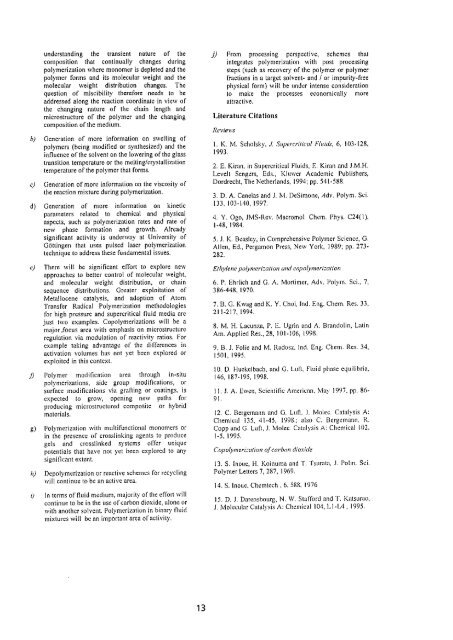March 3 - 5,1999, Karlsruhe, Germany - FZK
March 3 - 5,1999, Karlsruhe, Germany - FZK
March 3 - 5,1999, Karlsruhe, Germany - FZK
You also want an ePaper? Increase the reach of your titles
YUMPU automatically turns print PDFs into web optimized ePapers that Google loves.
understanding the transient nature of the<br />
composition that continually changes during<br />
polymerization where monomer is depleted and the<br />
polymer forms and its molecular weight and the<br />
molecular weight distribution changes. The<br />
question of miscibility therefore needs to be<br />
addressed along the reaction coordinate in view of<br />
the changing nature of the chain length and<br />
microstructure of the polymer and the changing<br />
composition of the medium.<br />
b) Generation of more information on swelling of<br />
polymers (being modified or synthesized) and the<br />
influence of the solvent on the lowering of the glass<br />
transition temperature or the melting/crystallization<br />
temperature of the polymer that forms.<br />
c) Generation of more information on the viscosity of<br />
the reaction mixture during polymerization.<br />
d) Generation of more information on kinetic<br />
parameters related to chemical and physical<br />
aspects, such as polymerization rates and rate of<br />
new phase formation and growth. Already<br />
significant activity is underway at University of<br />
Göttingen that uses pulsed laser polymerization<br />
technique to address these fundamental issues.<br />
e) There will be significant effort to explore new<br />
approaches to better control of molecular weight,<br />
and molecular weight distribution, or chain<br />
sequence distributions. Greater exploitation of<br />
Metallocene catalysis, and adoption of Atom<br />
Transfer Radical Polymerization methodologies<br />
for high pressure and supercritical fluid media are<br />
just two examples. Copolymerizations will be a<br />
major .focus area with emphasis on microstructure<br />
regulation via modulation of reactivity ratios. For<br />
example taking advantage of the differences in<br />
activation volumes has not yet been explored or<br />
exploited in this context.<br />
f) Polymer modification area through in-situ<br />
polymerizations, side group modifications, or<br />
surface modifications via grafting or coatings, is<br />
expected to grow, opening new paths for<br />
producing microstructured composite or hybrid<br />
materials.<br />
g) Polymerization with multifunctional monomers or<br />
in the presence of crosslinking agents to produce<br />
gels and crosslinked systems offer unique<br />
potentials that have not yet been explored to any<br />
significant extent.<br />
h) Depolymerization or reactive schemes for recycling<br />
will continue to be an active area.<br />
i) In terms of fluid medium, majority of the effort will<br />
continue to be in the use of carbon dioxide, alone or<br />
with another solvent. Polymerization in binary fluid<br />
mixtures will be an important area of activity.<br />
13<br />
j) From processing perspective, schemes that<br />
integrates polymerization with post processing<br />
steps (such as recovery of the polymer or polymer<br />
fractions in a target solvent- and / or impurity-free<br />
physical form) will be under intense consideration<br />
to make the processes economically more<br />
attractive.<br />
Literature Citations<br />
Reviews<br />
1. K. M. Scholsky, J. Supercritical Fluids, 6, 103-128,<br />
1993.<br />
2. E. Kiran, in Supercritical Fluids, E. Kiran and J.M.H.<br />
Levelt Sengers, Eds., Kluwer Academic Publishers,<br />
Dordrecht, The Netherlands, 1994; pp. 541-588.<br />
3. D. A. Canelas and J. M. DeSimone, Adv. Polym. Sei.<br />
133, 103-140, 1997.<br />
4. Y. Ogo, JMS-Rev. Macromol. Chem. Phys. C24(l),<br />
1-48, 1984.<br />
5. J. K. Beasley, in Comprehensive Polymer Science, G.<br />
Allen, Ed., Pergamon Press, New York, 1989; pp. 273-<br />
282.<br />
Ethylene polymerization and copolymerization<br />
6. P. Ehrlich and G. A. Mortimer, Adv. Polym. Sei., 7,<br />
386-448, 1970.<br />
7. B. G. Kwag and K. Y. Choi, Ind. Eng. Chem. Res. 33,<br />
211-217, 1994.<br />
8. M. H. Lacunza, P. E. Ugrin and A. Brandolin, Latin<br />
Am. Applied Res., 28, 101-106, 1998.<br />
9. B. J. Folie and M. Radosz. Ind. Eng. Chem. Res. 34,<br />
1501, 1995.<br />
10. D. Huekelbach, and G. Luft, Fluid phase equilibria,<br />
146, 187-195, 1998.<br />
11. J. A. Ewen, Scientific American, May 1997, pp. 86-<br />
91.<br />
12. C. Bergemann and G. Luft. J. Molec. Catalysis A:<br />
Chemical 135, 41-45, 1998.; also C. Bergemann, R.<br />
Copp and G. Luft, J. Molec. Catalysis A: Chemical 102,<br />
1-5, 1995.<br />
Copolymerization of carbon dioxide<br />
13. S. Inoue, H. Koinuma and T. Tsurata. J. Polin. Sei.<br />
Polymer Letters 7, 287, 1969.<br />
14. S. Inoue, Chemtech , 6, 588, 1976<br />
15. D. J. Darensbourg, N. W. Stafford and T. Katsurao,<br />
J. Molecular Catalysis A: Chemical 104, L1-L4, 1995.












![{A1[]Sp - Bibliothek](https://img.yumpu.com/21908054/1/184x260/a1sp-bibliothek.jpg?quality=85)




